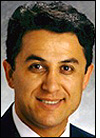Student researchers and professors in the Engineering Technology & Industrial Distribution (ETID) department of Texas A&M University are working with companies as diverse as a nursing home and a manufacturer of precast concrete to develop RFID applications, many of which combine RFID tags with environmental sensors.
The projects are being conceived and designed in the department’s Sensors and RFID Technologies Laboratory, a 2,000-square-foot facility opened last fall with financial support from the university and with tags, interrogators and sensors provided by several RFID equipment manufacturers, including Alien Technology, Axcess, Crossbow Technology, Dust Networks, Escort Memory Service, Intermec Technologies and TAGSys.
“In establishing the lab, our goal is to converge the sensor network technologies with RFID networks,” says Ben Zoghi, a professor and the lab’s director. “We used to use sensors in our labs just to control things, but until we added RFID, we never had a way to track the movement of the things we were sensing. We never had sensors that could communicate an ID. RFID adds real-time visibility to wireless sensor networks.”
The lab serves as a classroom for some of Zoghi’s courses on control systems that are part of the school’s Electrical Engineering Technology program. Working with two other faculty members and five student researchers in the five months since the lab’s opening, Zoghi has initiated a number of projects with businesses near the university and throughout Texas.
One of these projects involves a Houston-based distributor of hazardous chemicals used in the semiconductor and photo development industries. Zoghi and his team are designing a monitoring system utilizing active RFID tags, interrogators and exciters from Carrollton, Texas-based Axcess, combined with temperature and chemical sensors. The team plans to attach the tags and sensor devices to barrels of the distributor’s chemicals, including hydrofluoric acid and potassium hydroxide. They will then monitor the movement of the items through RFID interrogators in storage areas and in doorways. If the barrels are removed without permission, the system will alert personnel. The tags will also trigger alerts if the sensors are exposed to temperatures outside a set range, or if they detect a chemical odor signifying a potential leak.
One project Zoghi hopes to deploy would assist the staff of a nursing home near the university in monitoring the whereabouts of patients, some of whom suffer from cognitive problems. Patients would wear active RFID tags designed to trigger RFID readers with attached sensors that could alert the staff if a patient neared a particular doorway. Zoghi says the system could be linked to a security system that could lock particular doors if a patient approached. The system could also be linked to surveillance cameras, so that an interrogator would turn on the nearest camera upon sensing an ID tag. The system would then alert a nurse’s station.
However, Zoghi says, an application such as this could raise very serious concerns among the patients and their families, who may be uncomfortable with the notion of tracking patients’ movements. “It’s a matter of privacy, and also of conveying to the elderly patients what the system does and what it would be used for.”
Zoghi and his colleagues are also discussing a project with a company that manufactures precast concrete forms, such as electrical vaults and barriers. The firm wants to keep a better record of where its inventory is located within its yard, so Zoghi proposed a system using passive RFID tags and GPS receivers. The forklifts used to move the forms in and out of the yard would be equipped with RFID interrogators able to read passive tags attached to the forms. Mobile computers inside the forklifts would then combine the RFID tag data with GPS coordinates from a mobile GPS receiver installed on the forklift. The company would use this combined data to track inventory movements.
In the wake of the Sago mining accident in West Virginia last month, a student working at the lab suggested a personnel badge combining an active RFID tag with a carbon monoxide sensor could be used both to locate miners and to send alerts when exposed to gas. Based on this idea, Zoghi says the lab offered a proposal to the state of West Virginia, but has not received a response. “We had mixed feelings about this,” he says. “We don’t want to look like we’re being opportunistic [in the wake of a tragedy], but we feel like this could be a good application that could help locate miners.”
The Sensors and RFID Technologies Laboratory is not the first RFID-related research center at the university. The school also opened the RFiD2 Lab, which focuses on passive RFID technology for supply chain and asset tracking applications (see Keeping Track of Cadets’ Togs).


